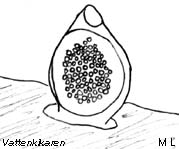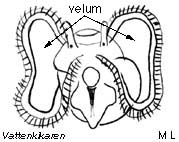|

Way
of life
|
|
What they eat
The Dogwhelk eats mainly small worms and
the like, aswell as carrion (dead animal material). The smell of food,
i.e. a crushed mussel, can bring the sea bottom to life. Within a minute
all the Dogwhelks within a radius of 20 cm from the prey became visible
above the bottom sediment and move quickly towards the pending meal. If
a number of Dogwhelks are studied closely soon after capture, about 80
% of them have empty stomachs. This indicates that they either have a
rapid digestive system or that they are undernourished. Common
starfish eat Dogwhelks, which occasionally escapes in a special way;
as soon as the soft part of the Dogwhelk is touched by the tube-feet (suckers)
of the starfish, the whelk stretches out its foot a distance from its
shell with surprising fexibility where it twists and turns, and then suddenly
dashes away in a series of jumps over the bottom.
Reproduction
The Dogwhelk lays small egg capsules that
they attach to seaweed, i.e. eel grass. There, they develope into small
larvae.
The whelk lays its egg capsules on bladder wrack, eel grass, rocks and
shells. This occurs mainly during the spring and summer. An egg capsule
can be up to 5 mm tall and contain between 50-100 eggs.

Egg capsule from a Dogwhelk, 5 mm tall
The eggs hatch after about a month and the resulting larvae are about
0,3 mm in size. The larvae have a velum which is used for propulsion and
to catch food. After about 8 weeks when the larvae have grown to 0,75
mm, they go through a transformation and fall to the bottom.

Larva from Netted Dogwhelk 0,3-0,75 mm
|

|
Page
2 of 2
|
|
|